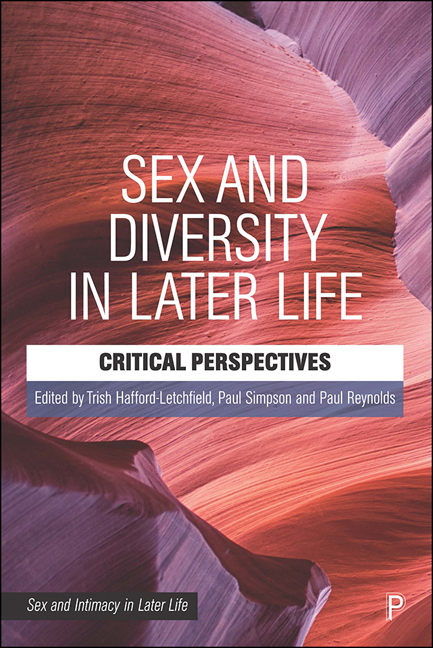Book contents
- Frontmatter
- Dedication
- Contents
- List of figures and tables
- Notes on editors and contributors
- Series editors’ introduction
- Foreword
- 1 Sex and intimacy in later life: a survey of the terrain
- 2 Sexual expression and pleasure among black minority ethnic older women
- 3 Sexual desires and intimacy needs in older persons and towards the end of life
- 4 Heterosexual sex, love and intimacy in later life: what have older women got to say?
- 5 Sex and ageing in older heterosexual men
- 6 Sex and older gay men
- 7 Thinking the unthinkable: older lesbians, sex and violence
- 8 Splitting hairs: Michel Foucault’s ‘heterotopia’ and bisexuality in later life
- 9 The age of rediscovery: what is it like to gender transition when you are 50 plus?
- 10 Ageing asexually: exploring desexualisation and ageing intimacies
- 11 Older people, sex and social class: unusual bedfellows?
- 12 Final reflections: themes on sex and intimacy in later life
- Index
9 - The age of rediscovery: what is it like to gender transition when you are 50 plus?
Published online by Cambridge University Press: 21 December 2021
- Frontmatter
- Dedication
- Contents
- List of figures and tables
- Notes on editors and contributors
- Series editors’ introduction
- Foreword
- 1 Sex and intimacy in later life: a survey of the terrain
- 2 Sexual expression and pleasure among black minority ethnic older women
- 3 Sexual desires and intimacy needs in older persons and towards the end of life
- 4 Heterosexual sex, love and intimacy in later life: what have older women got to say?
- 5 Sex and ageing in older heterosexual men
- 6 Sex and older gay men
- 7 Thinking the unthinkable: older lesbians, sex and violence
- 8 Splitting hairs: Michel Foucault’s ‘heterotopia’ and bisexuality in later life
- 9 The age of rediscovery: what is it like to gender transition when you are 50 plus?
- 10 Ageing asexually: exploring desexualisation and ageing intimacies
- 11 Older people, sex and social class: unusual bedfellows?
- 12 Final reflections: themes on sex and intimacy in later life
- Index
Summary
Introduction
Just a short time ago, we started to witness a slow but steady progression supporting the protection, inclusiveness and increased visibility of gender and sexual minorities. Almost half a century has passed since homosexuality was finally removed from the second edition of the Diagnostic and Statistical Manual of Mental Disorders (American Psychiatric Association, 1973), and now it is time for gender-diverse individuals to follow the very same steps. Only in 2019 did the World Health Organization recognise Gender Incongruence (HA60) to be a condition related to sexual health, rather than a mental health issue (WHO, 2020). Having excised the stigmatising stamp of ‘insanity’, we have been granted a golden opportunity to bring a compassionate understanding to the experiences of those who struggle with gender dysphoria; this is the central aim of this chapter.
There is a dearth of information surrounding the experiences of gender-diverse individuals that come to transition during their midlife, not only because the media has predominantly focused on voicing concerns around young transgender people, but also because there tends to be a general neglect of issues relating to older age. Individuals undergoing transition will often require support from multidisciplinary specialist teams composed of doctors, surgeons, psychologists, speech and language therapists, and many others. This reflects the bio-psycho-social nature of gender and the need for establishing a holistic approach when attempting to understand what it is like to transition when on the other side of 50.
To describe the process of transition, the chapter will first focus on the psychological processes involved in gender exploration. It is worth noting that not everyone proceeds with a physical transition and, when doing so, this comes at a later stage. Therefore, emulating the order in which most people experience these changes, the effects of physical interventions will be discussed in the final sections. Foremost, a common understanding of gender diversity and transition will be established. The section ‘Transition During Midlife, Why Now?’ shares an examination of likely life trajectories and the questioning involved in ‘coming out’. This will be followed by ‘Transition in Later Life, the Other Adolescence’, where the reader will consider the reenactment of experiences often associated with teenage years during the individual's midlife. In ‘Characteristics of the 50-plus Population’, the demographics of this group will be reviewed.
- Type
- Chapter
- Information
- Sex and Diversity in Later LifeCritical Perspectives, pp. 163 - 180Publisher: Bristol University PressPrint publication year: 2021

